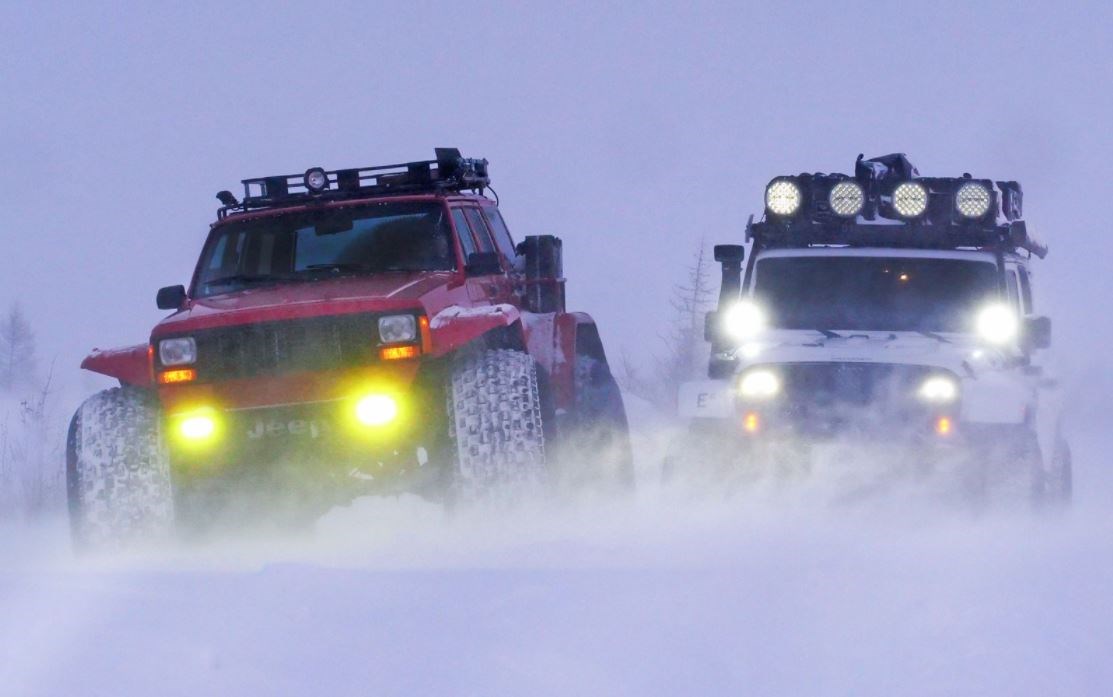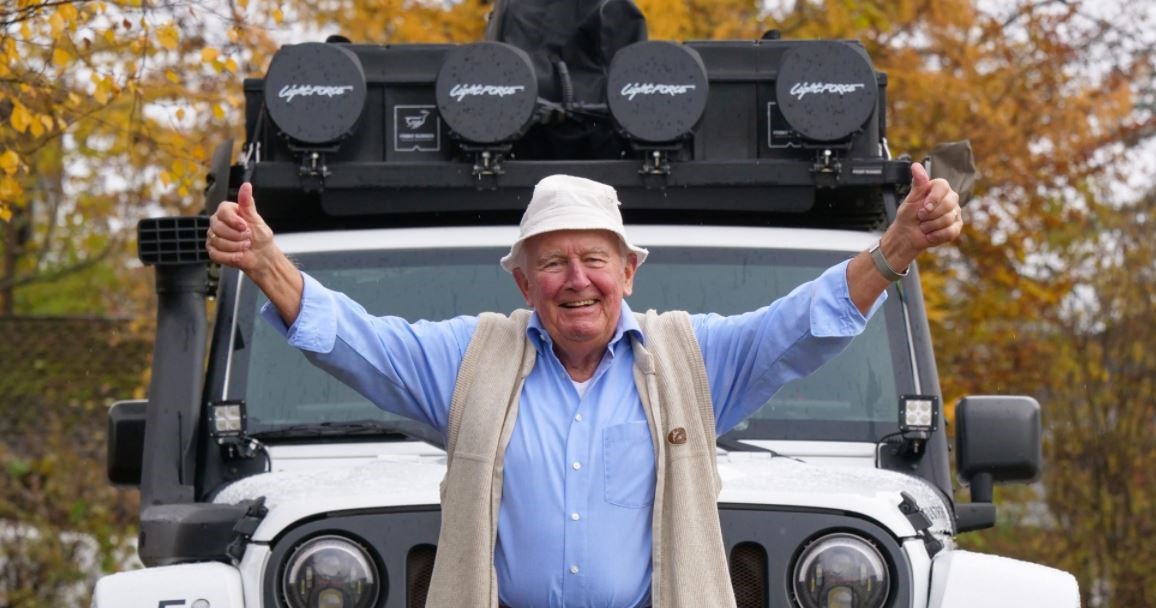On April 8th 2018, Bridget and I set off from arctic Alaska in our newly acquired Jeep ‘Gunther’. Our destination was Auckland, and our journey ahead would take us 3 years, 350,000 kilometres, across 7 continents and 90 countries.
It was only 4 months earlier that I had met Bridget and was drawn to her sprightly energy and enthusiasm. On our first date, we met at Pakari north of Auckland for a beach swim during a cyclone. For our second date, we drove to Mt Cook where we fumbled together a picnic in sub-zero temperatures. It was here that we discovered our mutual desire for extreme climates and off road adventure. During our drive back to Queenstown, we came up with the challenge of driving 80 countries in 80 weeks and at 1am, we shook hands and made an agreement that one day we would drive the world together.
The next morning, I learned one of Bridget’s most redeeming qualities; she doesn’t fluff around! She was out of bed and eagerly drawing a route map from Ushaia to Cape Town. Our route soon grew from 80 weeks, to 3 years and many more kilometres. While she was immersed in route planning, I took the opportunity to jump online to see what vehicle we would need to get us through 6 continents.
I had remembered reading about a Bavarian man who spent 25 years circumnavigating the world in his G Wagen. His story was almost unbelievable, that he had travelled 500,000 km’s in his modest little car named Otto. His name was Gunther Holtorf and together with his wife travelled to 177 countries. His wife passed away on the journey but Gunther went on to become one of the most travelled men in history.
We found Gunther and Otto’s journey inspiring. With his G Wagen essentially in factory settings, Mr Holtorf taught us that we did not need a Unimog size vehicle to be self-sufficient.
We knew that we wanted to take our vehicle to some of the world’s most challenging climates and dangerous countries so sleeping in the car was an essential criteria.
We found ourselves at Andrew Simms in New Market a week later testing the comforts of lying flat in the back of a Jeep Wrangler. With the rear seats positioned forward, we were able to lie flat quite comfortably. It was cosy, which Bridget was very happy about, so the decision was made and we started our hunt for a suitable Wrangler in North America.
Because we wanted to launch our journey from the most northern drivable point on the planet, we began looking at Rubicon Wrangler’s in Anchorage, Alaska. We noticed that almost all of the available cars had superficial rust in their undercarriage due to the amount of salt used on the Alaskan roads during the winter months. Because of this, we moved our focus 3,500km south to Vancouver where we began trudging through various options. After a few Skype video calls with a very sceptical salesman and his white JK Rubicon, we decided to book our flights to Canada to meet our third companion, who would become known as ‘Gunther’.
Bridget and I decided upon Gunther’s white colour and large black ‘E’ decal to resemble a UN peace keeping vehicle. White is supposedly the least threatening colour choice as well as the most visible for on road safety. We believe that the UN resemblance has paid dividends when navigating road blocks and petty corruption in Africa and Nicaragua during its civil unrest.
Leg 1 took us from Deadhorse, 700kms above the arctic circle in Alaska, to the most southern town on earth, Ushaia. With a large portion of the drive being spent on the world's longest road, the ‘Pan-American Highway’, our first year on expedition was all about learning the boundaries of the car, our equipment and our relationship!

After his shipment from Buenos Aires, we were reunited with Gunther in early 2019 on the shores of South Africa. Johannesburg is home to some of the most savvy 4x4 mechanics on the planet. We maximised the opportunity and worked with the team at Front Runner to fix some of the niggles that had been bothering us through leg 1. A key piece of advice to anyone doing a long journey by car, is to keep your vehicle simple. There is truth behind ‘quality over quantity.’
Through northern Africa we were reliant on sourcing fuel through the black market which came with many consequences. The low quality petrol was frequently diluted with water which we had to separate using cut water bottles. When we eventually reached Istanbul we were able to work with a team of mechanics to rebuild parts of Gunther’s engine that had been badly damaged due to this process.
When we eventually completed Leg 2 in the Nordkapp of Norway, we received an email from Mr Gunther Holtorf inviting us to join him for breakfast at his home in Bavaria. Because of the distance we had just travelled, a 5 day detour was no big deal.

Mr Holtorf (83) had a tear in his eye as he stroked his name which is printed along the side of Gunther’s bonnet. Over a Bavarian breakfast of bratwurst and mustard, Bridget and I spent the time exchanging stories and environmental findings with the man that inspired so much of our journey. Mr Holtorf retired Otto to the Mercedes Museum in Stuttgart but has since purchased another 1986 G Wagen named Otto 2 which spends most of its time travelling through South America when Mr Holtorf escapes the German winter. We remain in regular contact with Mr Holtorf and exchange emails with him weekly.
The next year, we set off to tackle Leg 3 from Russia to New Zealand. We were high in the Siberian arctic when were informed by the embassy that Russia was closing its borders. We had no choice but to leave Gunther in a carpark at Moscow Airport with a one year parking ticket which we negotiated with a parking warden through Google Translate. Every now and then we receive a message from the warden, who sends us photos of “Mr Gunther” who has now been sitting idle for over a year. Even Google Earth has picked him up, camouflaged in a snowy empty car park.
Since our departure, we have taken Gunther to the highest, lowest, driest, hottest and most dangerous roads on the planet. He has crossed both the equator and arctic circle twice, and the total distance he has driven equates to the length of New Zealand 103 times or half way to the moon. But we have never feared for his safety more than we are now. Because Gunther was only granted a 3 month entry visa for Russia, he now has an illegal status and will be seized by officials if found.
Mr Holtorf has become increasingly concerned about ‘his sons’ status in Russia and has recently engaged a team from Mercedes in Moscow to rescue Gunther from the wardens who are now refusing to release his keys. Because of fraud in Russia, this has become quite a complicated problem which could be a very expensive one to resolve. We are hoping the team there will be able to retrieve Gunther and keep him safe until our return whenever it may be.
We do not believe it will be responsible to continue our journey until the borders have officially been open along our leg 3 route, which takes us through a further 23 countries.
View this post on Instagram
During this down time, we have been working on building a secondary vehicle that will join us on future expeditions alongside Gunther. This longer wheel base version of Gunther is a JT Gladiator, which will eventually carry a different set up that will be complimentary to our expeditions. There is certainly safety in numbers when overlanding and having a second vehicle will mean we can push ourselves even further into challenging terrain. We have named the vehicle Roman after the Siberian man who helped navigate us higher than any ‘civilian’ vehicle in Siberia's Yamal peninsula.
Until we return to Gunther, we will be exploring some of New Zealand’s most off trail locations from Exhibition Bay in the Far North, to remote parts of Fiordland. New Zealand is an excellent training ground for an overland expedition. The only problem is, it doesn’t get much better!









